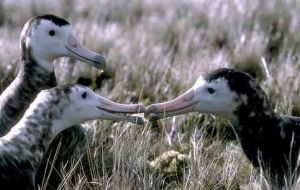MercoPress. South Atlantic News Agency
The world’s rarest albatross confirmed as a separate species by scientists
 The birds breed on a single volcanic island (Photo by Storm Petrel 1/Dominique Filipini)
The birds breed on a single volcanic island (Photo by Storm Petrel 1/Dominique Filipini) The world's rarest albatross has been confirmed as a separate species by scientists. The genetic analysis solves 20 years of debate over the status of the Amsterdam albatross.
Canadian researchers have proven that the birds' DNA varies significantly from wandering albatrosses, their closest living relatives.
Only 170 of the birds remain on Amsterdam Island where the whole population breed on a single plateau.
Amsterdam albatrosses are very large seabirds that can weigh up to 8kg and have wingspans as large as 3.5m. The birds are named after Amsterdam Island in the Indian Ocean, which they use as a breeding ground.
They were first discovered in 1983, but the scientific community has since been divided over whether they are a separate species. Some scientists believed the birds to be a subspecies of the wandering albatross, which also inhabits the Southern Ocean.
Dr Theresa Burg and her colleagues from the University of Lethbridge, Canada, set out to solve the debate by examining the birds' DNA. Their findings are published in the Journal of Avian Biology.
Dr Burg explained that Amsterdam albatrosses differ in appearance from wandering albatrosses.
“They are slightly smaller in size,” she said. “They lay their eggs at a different time and have slightly browner plumage than the other wandering albatrosses.”
The team's study also revealed significant differences between the birds' DNA. The analysis showed that Amsterdam albatrosses separated from their cousins, becoming a genetically distinct species, up to 265,000 years ago.
Despite their large wingspan and ability to fly for long distances, Amsterdam albatrosses always return to the same breeding grounds on a single plateau of the island.
They do not share this breeding ground with any other wandering albatrosses and researchers suggest that this geographical isolation is what led the birds to develop as a separate species. Scientists hope that now the birds are recognised as unique, efforts to conserve them will increase.
“This is one additional, but important, piece of evidence that hopefully can help protect the remaining Amsterdam albatrosses,” says Dr Burg.
While the current population is considered stable, the Amsterdam albatross is critically endangered.
An estimated 18-26 pairs breed each year in a tiny area at the centre of the island. Pairs mate for life and produce one egg every other year.
Conservationists say the species' survival is threatened by accidental entanglement in long-line fishing gear and nest-site disturbance by domestic animals.




Top Comments
Disclaimer & comment rulesCommenting for this story is now closed.
If you have a Facebook account, become a fan and comment on our Facebook Page!